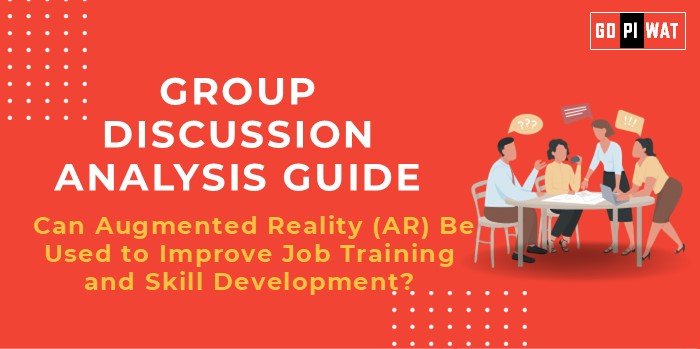📋 Group Discussion Analysis Guide: Can Augmented Reality (AR) Be Used to Improve Job Training and Skill Development?
🌐 Introduction to the Topic
- 📖 Opening Context: “Augmented Reality (AR) has rapidly evolved from being an entertainment tool to a transformative force in industries like healthcare, manufacturing, and education. Its potential in job training and skill development offers a dynamic approach to bridging skills gaps globally.”
- 🔍 Topic Background: AR combines digital overlays with real-world environments to provide immersive learning experiences. Since the introduction of commercial AR applications in the 2010s, its use in corporate and educational training has surged, enhancing practical learning, reducing costs, and offering scalable solutions. Recent innovations include AR-powered remote collaboration tools and simulation-based training platforms.
📊 Quick Facts and Key Statistics
🌍 Global AR Market Size: $39 billion in 2023 (Statista) – Highlights the technology’s growing adoption.
💡 Training Effectiveness: 75% of learners retained information better using AR (Harvard Business Review).
💰 Cost Reduction: 30% lower training costs reported by AR adopters (PwC).
⏳ Time Savings: Training time reduced by 40% with AR simulations (McKinsey).
💡 Training Effectiveness: 75% of learners retained information better using AR (Harvard Business Review).
💰 Cost Reduction: 30% lower training costs reported by AR adopters (PwC).
⏳ Time Savings: Training time reduced by 40% with AR simulations (McKinsey).
🤝 Stakeholders and Their Roles
- 🏫 Educational Institutions: Develop AR-integrated curricula.
- 💼 Corporates: Deploy AR tools for employee upskilling and operational efficiency.
- 💻 Tech Developers: Create AR hardware and software tailored to training needs.
- 🏛️ Government Bodies: Fund AR-based educational initiatives for skill development.
🏆 Achievements and Challenges
✨ Achievements
- 📈 Improved Skill Retention: Studies show AR training enhances memory retention by 70% over traditional methods.
- 🛩️ Real-World Simulations: Used in aviation, AR helps train pilots in safe, controlled environments.
- 🌎 Global Adoption: Companies like Boeing and Walmart have integrated AR training programs with measurable productivity gains.
⚠️ Challenges
- 💸 High Initial Costs: AR hardware and content development can be prohibitively expensive.
- 📶 Digital Divide: Uneven access to AR tools in developing countries.
- ⚙️ Integration Issues: Limited compatibility with existing training systems.
🌍 Global Comparisons
- 🇺🇸 United States: Extensive AR adoption in defense and healthcare.
- 🇮🇳 India: AR startup boom but limited adoption in rural areas.
- 📖 Case Studies:
- Siemens: Leveraged AR for training factory workers, reducing errors by 50%.
- Walmart: Trained over 1 million associates in customer service using AR.
🗨️ Structured Arguments for Discussion
- 👍 Supporting Stance: “AR transforms traditional training into engaging, interactive experiences, improving efficiency and retention rates.”
- 👎 Opposing Stance: “High costs and technology barriers make AR inaccessible for smaller organizations.”
- ⚖️ Balanced Perspective: “While AR offers substantial benefits in training, its full potential requires broader accessibility and reduced costs.”
💡 Effective Discussion Approaches
- 📊 Opening Approaches:
- “Global industries are increasingly leveraging AR to meet modern workforce demands.”
- “AR’s success in training environments like aviation and healthcare highlights its potential.”
- 💬 Counter-Argument Handling:
- Use real-world examples to address cost concerns, such as subscription-based AR platforms.
- Highlight ongoing efforts to make AR accessible in underserved regions.
🔍 Strategic Analysis of Strengths and Weaknesses
- 💪 Strengths: Immersive learning, scalability, enhanced retention.
- 💔 Weaknesses: High costs, technology adoption barriers.
- 🚀 Opportunities: 5G integration, broader software availability.
- ⚡ Threats: Competition from Virtual Reality (VR), lack of standardization.
🎓 Connecting with B-School Applications
- 📘 Real-World Applications:
- Use AR for case competitions, logistics simulations, or operations management exercises.
- 🗨️ Sample Interview Questions:
- “What industries can benefit most from AR in training?”
- “How can AR be made affordable for small businesses?”
- 📖 Insights for B-School Students:
- Explore AR’s use in operational efficiency and change management strategies.


